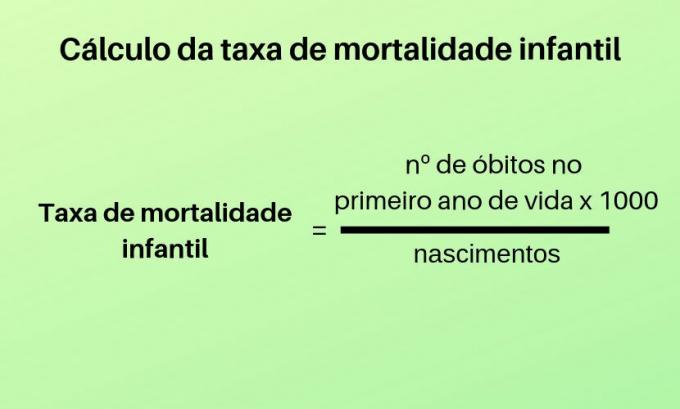birth rates and mortality represent human development indicators that analyze both population increase and decline. They allow analyzing the dynamics of a population, according to the variables that influence them, such as quality of life, income, level of development of the country or federative unit in question. In Geography, this study is carried out by the area of knowledge called Demography.
knowalso:Brazilian population growth
Birth rate
THE birth rate refers to the calculation that indicates the number of live births over a year per thousand inhabitants. This calculation does not consider the number of children who died after birth or who were born dead.
This indicator makes it possible to make a analyzeofdevelopmentsocioeconomic of the place in question. This rate is usually high in less industrialized or underdeveloped countries and declining in industrialized or developed countries. Developing countries, despite still having high birth rates, are heading towards their decline.
when the birth rate is low, it can be said that in that place there is possible public policies of family planning, there is access to effective health and education. The opposite occurs when this rate is high. Normally, in these places there is precariousness in the health and education sectors, little family planning and inefficient public policies.
→ Calculation of birth rate
The calculation is based on the relationship between the number of live births in a year and the number of inhabitants in the place. The result is expressed as a percentage.

For example, if 1200 children were born in a certain place and the population total is 1,000,000 inhabitants, the birth rate will be 1.2‰. This means that for every thousand inhabitants, about one child is born a year.
Mortality rate
THE mortality rate refers to the calculation that indicates the n.number of deaths over a year per thousand inhabitants. This demographic indicator makes it possible to analyze the socioeconomic conditions of a given place.
Usually, this rate presents high in underdeveloped and developing countries, whose politicssocialthey areprecarious, where there are high rates of violence, where there is a greater occurrence of diseases among the population due to poor access to health, vaccines and medicines.
In developed countries, this rate tends to be reduced. At better conditions in these countries favor better health care, better access to medicines and vaccines, basic sanitation and efficient public policies favor the reduction of this rate.
→ Calculation of mortality rate
The calculation is based on the relationship between the number of deaths in a year and the number of inhabitants in a given place. The result is expressed as a percentage.

Suppose that in a place there are 500,000 inhabitants and 1,000 people die each year, the mortality rate will be 2‰. This means that 2 people per thousand inhabitants die in this place in a year.
Child mortality rate
THE child mortality rate refers to the number of children who die before the first year of life. It is calculated for every thousand children who are born alive in a period of one year. This indicator is of enormous relevance for analyzes on the population and on the development of a country, since it currently reduces the child mortality is one of the main government goals for childhood in all countries, according to the United Nations Children's Fund (Unicef).
→ Calculation of infant mortality rate
The calculation is based on the ratio between the number of deaths before the first year of life and the number of births per thousand children born alive. The result is expressed as a percentage.

If in a given place there are 20 deaths before the first year of life, and 800 children are born within a year, the infant mortality rate is 25‰. This means that 25 children die before reaching one year of life for every 1000 children born alive.
vegetative growth
O vegetative growth refers to difference between the birth rate and the death rate over a year. It is also known as natural growth. Added to the migration rate, it is possible to calculate the demographic growth of the place in question.

fertility rate
fertility rate refers to average number of children per woman throughout her reproductive period. According to the United Nations Population Fund, the fertility rate per woman is 2.52 children.
World birth and mortality rates
According to an analysis of the Global Burden of Diseases, carried out in 2017, there is a significant decline in the number of births, which means that there is a significant decrease in the birth rate.
This was possible to see through a study that analyzed the fertility rate in 195 countries, between 1950 and 2017. The result shows that half of the countries have a fertility rate below the replacement level. This means that populations tend to shrink.
Read too:Distribution of world population
Population growth is still expressive worldwide. The planet surpassed 7 billion inhabitants in the beginning of the 21st century, however, predictions made by United Nations (UN) point out that atfeesingrowthpresentfall around the world, and that by 2050, after reaching 10 billion people, the world population will begin to decline.
THE high birth rate and also the mortality rate is still characteristic of underdeveloped countries as a result of social and economic factors. Generally, in these countries, there is precariousness in public health systems, education still does not reach the all or operates inefficiently, there are high levels of violence, misery, hunger and worsening of illnesses.
US developed countries, birth and mortality rates show a decline, given the birth control policies that are used, the better quality of life of the population, the low levels of violence and poverty.
Birth and mortality rate in Brazil

Brazil is a very populous country, however, population growth has been declining.
According to data released by the United Nations Population Fund (UNFPA), Brazil is one of the countries with a drop in births. The country's fertility rate is 1.7, which is below the population replacement level, which is 2.2 and was recorded in all regions of the country.
According to UNFPA, this has happened due to the greater access to information and services through social programs. The drop in the mortality rate is also one of the factors that contributed to the decrease in the number of births.
readmore:Distribution of the Brazilian population
The UN estimates, through the analysis of birth and mortality rates, that Brazil will no longer be the fifth-largest most populous nation in the world In the next years. Factors such as the increase in urbanization that changed the way of life of families, the insertion of women in the labor market, among others.
In the country, despite still living with poverty and hunger, the mortality rate has also dropped and the country is aging. Advances in medicine have allowed greater access to vaccines, medicines and better health care as well as a signaling the improvement of life in aspects such as more efficient public policies and improved sanitation basic.
O Brazilian Institute of Geography and Statistics reveals that the birth rate in Brazil has decreased. In 2000, the rate was 20.86 per thousand inhabitants, dropping to 14.16 in 2015. The death rate also declined. In 2000 it was 6.67 per thousand inhabitants, dropping to 6.08 in 2015.



